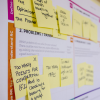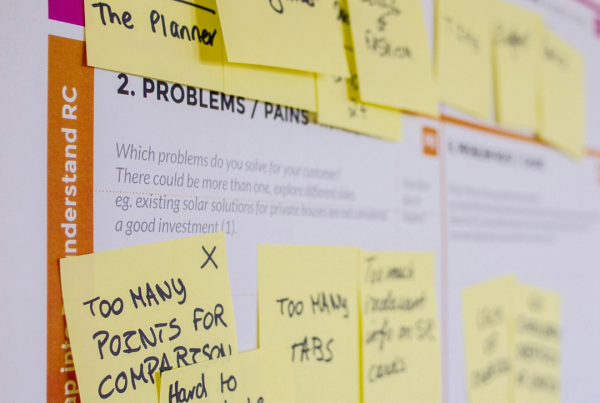The larger your organisation gets, the bigger the teams and the more processes you’ll have. This is the problem with scaling up. As teams expand and demand increases, bureaucracy tends to creep in, slowing execution and stifling creativity.
Eventually, your product design becomes too complicated for users. A bloated design is loaded with unnecessary or unused features, which often deviate from its original purpose. Firstly, let’s look at the typical signs you have design bloat:
- User reviews are generally negative or have turned negative over the years
- An inadequate feedback loop, where teams don’t fully understand the design impact on users.
- A simple product update can take many months, approval processes are long-winded, and decisions take considerable time
- Constant rework that delays delivery
- Teams are not communicating effectively, leading to misunderstandings and duplicated effort
- Increased development costs, requiring more resources to design, build, and maintain the product
A bloated product design usually stems from a combination of factors. It could be due to an unclear product vision, inadequate design review, or pressure to constantly deliver new features.
An ineffective organisational structure also adds bureaucratic layers, while a micromanagement culture adds unnecessary processes. Sometimes, it’s down to a legacy of baggage such as redundant processes, excessive meetings, and disjointed workflows.
How to Start Reducing Design Bloat and Being Lean
Design bloat doesn’t happen overnight. It’s usually a series of bad decisions accumulating over time. I’ll discuss a few strategies to start being lean.
Identify Bottlenecks
Find the most significant bottlenecks in the design process and areas of waste. You can start by mapping all your processes, workflows, and tools to understand where the slowdown is occurring and identify duplicated efforts or unnecessary work. For instance, a lengthy approval process for minor design changes can be a significant drain on time and resources.
Pinpoint What Users Deem as Valuable
Understand what your users consider as “value” that they would be willing to pay for. It may be helpful to revisit the product vision and think about the problems your product is trying to solve and the user needs that it’s trying to meet.
Focus on understanding user needs through research, feedback, and data review to ensure your efforts are aligned with what truly matters to paying users.
Run a Design Audit
Conduct a design audit and study product metrics. What are the underutilised features, and are they necessary? By diving into analytics, you can identify duplicated or extra steps that are complicating the product.
Focus on Usability
Users will struggle to use your product when there’s too much bloat. Completing a simple task can become confusing, and users often end up quitting.
One indicator is when a product requires extensive customisation for it to work for users. Another is when you have an overly long onboarding process. If users must spend a long time learning how to use your product, then your product isn’t usable in the first place.
Adopt a Product Cycle Focused on Small Improvements
An efficient design, test, build, and improve cycle will significantly reduce the risks of product design bloat. When you’re focused on delivering small improvements quickly, you’re taking a smaller bet that’s easily fixable if the outcome bombs with customers.
In contrast, delivering a major upgrade that fails to deliver is much riskier, costing more, and wasting more time.
Simplify Team Structure and Processes
Encourage collaboration among cross-functional teams, including customer service, sales, design, and development. To do this, you need to remove guardrails and refrain from micromanaging teams.
Review existing processes and tools to simplify them. Fewer processes and approval layers will provide more clarity and faster executions. Try to consolidate and integrate tools into one overarching system to reduce misunderstandings and eliminate bottlenecks.
Create Smoother Workflows
Smoother workflows will speed up collaboration between teams and minimise interruptions. One way to achieve this is to establish clear responsibilities and streamline communication channels. Break down large projects or tasks into more manageable work so that teams can deliver.
Monitor Your Progress
Focus on tracking solid metrics to show stakeholders that all the structural and process changes are making a real impact. You can measure lead time, customer adoption rates, feature utilisation, return on investment (ROI), and team engagement.
Start Small and Be Consistent
One advice I’d give is don’t try to change everything drastically. You can start with one area or a pilot project with the quickest win. Remember, it’s a journey of continuous improvement for your organisation.
Culture also takes time to change, and it’s about continually educating and engaging with people. It helps to find individuals who can champion the change and provide guidance to other team members. Make time for regular reviews and provide opportunities for feedback for teams.
The Bottom Line
Design bloat can be inevitable when scaling up quickly. This usually stems from unclear vision, poor feedback loops, constant pressure to add features, or outdated processes and structures.
As a product leader or executive, focus on designing for small improvements, empowering teams, streamlining processes, consolidating tools, and reducing waste.
You don’t need to overhaul everything at once. Start gradually, beginning with one process or one team. Over time, these small, steady changes will compound and build a leaner organisation.







